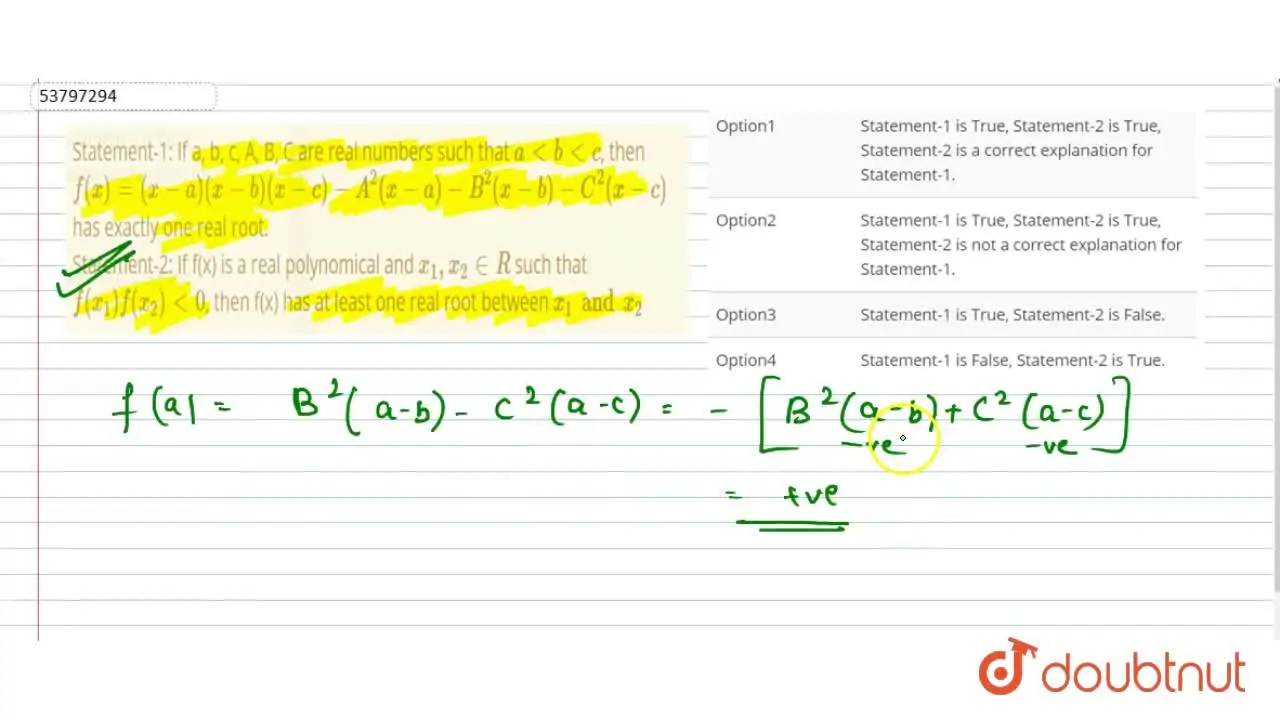Statement-1: If a, b, c, A, B, C are real numbers such that a<b<c, then f(x)=(x−a)(x−b)(x−c)−A2(x−a)−B2(x−b)−C2(x−c) has exactly one real root.
Statement-2: If f(x) is a real polynomical and x1,x2∈R such that f(x1)f(x2)<0, then f(x) has at least one real root between x1andx2
Statement-1 is True, Statement-2 is True, Statement-2 is a correct explanation for Statement-1.
Statement-1 is True, Statement-2 is True, Statement-2 is not a correct explanation for Statement-1.
Statement-1 is True, Statement-2 is False.
Statement-1 is False, Statement-2 is True.
The correct Answer is:D
Clearly, statement-2 is true. (See Theory)
We have, f(a)=−B2(a−b)−C2(a−c)=−[B2(a−b)+C2(a−c)]>0and,f(c)=−[A2(c−a)+(c−b)B2]<0
Also, f(x)→−∞asx→−∞andf(x)→∞asx→∞.
Thus, f(x) changes its signs from positive to negative or negative to positive in the intervals (−∞,a),(a,c)and(c,∞). Hence, f(x) has three real roots.
Related Playlists
- BOOK - OBJECTIVE RD SHARMACHAPTER - QUADRATIC EXPRESSIONS AND EQUATIONS EXERCISE - Exercise138videos
QUADRATIC EXPRESSIONS AND EQUATIONS
- BOOK - OBJECTIVE RD SHARMACHAPTER - QUADRATIC EXPRESSIONS AND EQUATIONS EXERCISE - Chapter Test50videos
QUADRATIC EXPRESSIONS AND EQUATIONS
- BOOK - OBJECTIVE RD SHARMACHAPTER - QUADRATIC EXPRESSIONS AND EQUATIONS EXERCISE - Section I - Solved Mcqs123videos
QUADRATIC EXPRESSIONS AND EQUATIONS
- BOOK - OBJECTIVE RD SHARMACHAPTER - PROBABILITY EXERCISE - Chapter Test45videos
PROBABILITY
- BOOK - OBJECTIVE RD SHARMACHAPTER - SEQUENCES AND SERIESEXERCISE - Chapter Test60videos
SEQUENCES AND SERIES
Similar Questions
Statement-1: Ifαandβ are real roots of the quadratic equations ax2+bx+c=0and−ax2+bx+c=0, then a2x2+bx+c=0 has a real root between αandβ
Statement-2: If f(x) is a real polynomial and x1,x2∈R such that f(x1)fx2<0, then f(x) = 0 has at leat one real root between x1andx2.View SolutionLet f(x)=0 be an equation and x1,x2, be.two real numbers such that f(x1)f(x2)<0, then f(x)=0 has
View SolutionStatement-1: The equation πex−e+eπx−π+ππ+eex−π−e=0 has real roots.
Statement-2: If f(x) is a polynomial and a, b are two real numbers such that f(a)f(b)<0, then f(x) = 0 has an odd number of real roots between a and b.View SolutionStatement-1: Ifa,b,c∈Rand2a+3b+6c=0, then the equation ax2+bx+c=0 has at least one real root in (0, 1).
Statement-2: If f(x) is a polynomial which assumes both positive and negative values, then it has at least one real root.View SolutionIf a<b<c<d then show that (x−a)(x−c)+3(x−b)(x−d)=0 has real and distinct roots.
View SolutionStatement-1: If a, b, c are distinct real numbers, then a(x−b)(x−c)(a−b)(a−c)+b(x−c)(x−a)(b−c)(b−a)+c(x−a)(x−b)(c−a)(c−b)=x for each real x.
Statement-2: Ifa,b,c∈R such that ax2+bx+c=0 for three distinct real values of x, then a=b=c=0 i.e. ax2+bx+c=0 for all x∈R.View SolutionStatement -1 : one root of the equation x2+5x−7=0 lie in the interval (1,2).
and
Statement -2 : For a polynomial f(x),if f(p)f(q) lt 0, then there exists at least one real root of f(x) =0 in (p,q)View SolutionLet f(x)=asinx+c, where a and c are real numbers and a>0. Then f(x)<0,∀x∈R if
View SolutionStatement-1: Let a,b,c be non zero real numbers and f(x)=ax2+bx+c satisfying ∫10(1+cos8x)f(x)dx=∫20(1+cos8x)f(x)dx then the equation f(x)=0 has at least one root in (0,2).Statement-2: If ∫bag(x)dx vanishes and g(x) is continuous then the equation g(x)=0 has at least one real root in (a,b). (A) Both 1 and 2 are true and 2 is the correct explanation of 1 (B) Both 1 and 2 are true and 2 is not correct explanation of 1 (C) 1 is true but 2 is false (D) 1 is false but 2 is true
View Solutionif a <c<b, then check the nature of roots of the equation
(a−b)2x2+2(a+b−2c)x+1=0View Solution


